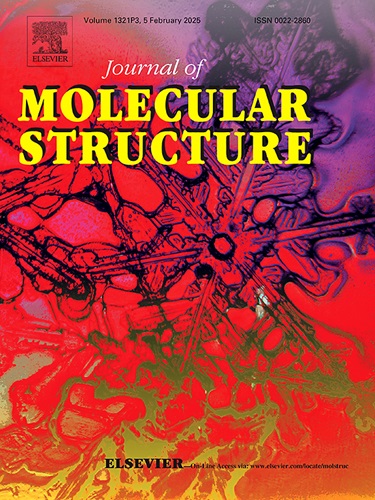Synthesis, characterization and biological evaluation of new thiadiazole derivatives: Antibacterial, antifungal, antioxidant, anticancer, simulation studies
IF 4
2区 化学
Q2 CHEMISTRY, PHYSICAL
引用次数: 0
Abstract
Due to the growing resistance of some drugs and the need for safe chemotherapeutic agents, five new compounds (VII1–5) were synthesized and characterized by elemental analysis, FT-IR, 1H and 13C NMR techniques. The compounds were tested for their antibacterial, antifungal, antioxidant and anticancer activities. Among the reported compounds, VII5 molecule showed excellent antibacterial, antifungal, antioxidant and anticancer activities. Also, compound VII5 did not show any toxic effect on normal mouse fibroblast cells. In the case of antioxidant activities, the IC50 values (μg/mL) of molecule VII5 and ascorbic acid with DPPH were 277.27 and 393.48 while these values with FRAP were 218.52 and 518.10, respectively. The IC50 values (μg/mL) of compounds VII5 with Colon (HCT116), Lung (A549), Breast (MCF-7) and Fibroblast (L929) were 76.06, 121.25, 37.5 and 461.36, respectively. The simulation study confirmed strong binding to DNA through hydrogen bonding and hydrophobic interactions. The affinity energy was -5.4 kcal/mol with 4 hydrogen bonds. Ultimately, it was concluded that the synthesized compound VII5 exhibited a broad spectrum of biological activities and has potential therapeutic applications for various diseases like fungal infections and cancer in comparison to conventional medication.

新型噻二唑衍生物的合成、表征及生物学评价:抗菌、抗真菌、抗氧化、抗癌、模拟研究
由于一些药物的耐药性增加和对安全化疗药物的需求,合成了5个新化合物(VII1-5),并通过元素分析、FT-IR、1H和13C NMR技术对其进行了表征。测定了化合物的抗菌、抗真菌、抗氧化和抗癌活性。在已报道的化合物中,VII5分子具有良好的抗菌、抗真菌、抗氧化和抗癌活性。此外,化合物VII5对正常小鼠成纤维细胞无任何毒性作用。抗氧化活性方面,VII5和抗坏血酸与DPPH的IC50值(μg/mL)分别为277.27和393.48,与FRAP的IC50值分别为218.52和518.10。化合物VII5与结肠(HCT116)、肺(A549)、乳腺(MCF-7)和成纤维细胞(L929)的IC50值(μg/mL)分别为76.06、121.25、37.5和461.36。模拟研究证实了通过氢键和疏水相互作用与DNA的强结合。亲和能为-5.4 kcal/mol,有4个氢键。最终得出结论,与传统药物相比,合成的化合物VII5具有广泛的生物活性,对真菌感染和癌症等多种疾病具有潜在的治疗应用。
本文章由计算机程序翻译,如有差异,请以英文原文为准。
求助全文
约1分钟内获得全文
求助全文
来源期刊

Journal of Molecular Structure
化学-物理化学
CiteScore
7.10
自引率
15.80%
发文量
2384
审稿时长
45 days
期刊介绍:
The Journal of Molecular Structure is dedicated to the publication of full-length articles and review papers, providing important new structural information on all types of chemical species including:
• Stable and unstable molecules in all types of environments (vapour, molecular beam, liquid, solution, liquid crystal, solid state, matrix-isolated, surface-absorbed etc.)
• Chemical intermediates
• Molecules in excited states
• Biological molecules
• Polymers.
The methods used may include any combination of spectroscopic and non-spectroscopic techniques, for example:
• Infrared spectroscopy (mid, far, near)
• Raman spectroscopy and non-linear Raman methods (CARS, etc.)
• Electronic absorption spectroscopy
• Optical rotatory dispersion and circular dichroism
• Fluorescence and phosphorescence techniques
• Electron spectroscopies (PES, XPS), EXAFS, etc.
• Microwave spectroscopy
• Electron diffraction
• NMR and ESR spectroscopies
• Mössbauer spectroscopy
• X-ray crystallography
• Charge Density Analyses
• Computational Studies (supplementing experimental methods)
We encourage publications combining theoretical and experimental approaches. The structural insights gained by the studies should be correlated with the properties, activity and/ or reactivity of the molecule under investigation and the relevance of this molecule and its implications should be discussed.
 求助内容:
求助内容: 应助结果提醒方式:
应助结果提醒方式:


